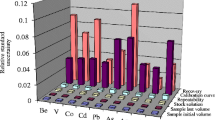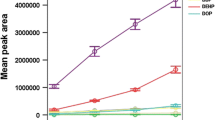Abstract
To determine patulin in various fruit juices, high performance liquid chromatography (HPLC) method was optimized and validated. For validation of HPLC method, a linearity, accuracy, precision, detection limit, and quantification limit were determined. Linearity (R2 = 0.99995), accuracy (96.1–115.7%), precision (3.31–9.52), detection limit (6 ng/mL), and quantification limit (8 ng/mL) were in agreement with performance criteria for patulin as set by the European Commission hence proved that HPLC can be used to detect patulin in fruit juices. After validation, the method was applied to estimate the prevalence of patulin in fruit juices (apple, grape, and orange juices). Nine samples (12.5%, 3 apple, 2 orange, and 4 grape juices) of 72 samples were positive for patulin in the range 2.8 to 30.9 ng/mL. According to the monitoring results, daily intake was estimated to be 0.17 ng/kg BW/day which was lower than the provisional maximum tolerable daily intake (0.4 μg/kg) established by Joint Expert Committee on Food Additives. These results indicate that the detection method coincides with the performance criteria and is appropriate for analysis of patulin, and continuous monitoring of patulin in various fruit juices from Korea is necessary.
Similar content being viewed by others
References
Baert K, De Meulenaer B, Kasase C, Huyghebaert A, Ooghe W, Devlieghere F. Free and bound patulin in cloudy apple juice. Food Chem. 100: 1278–1282 (2007)
Boonzaaijer G, Bobeldijk I, van Osenbruggen WA. Analysis of patulin in dutch food, an evaluation of a SPE based method. Food Control 16: 587–591 (2005)
Shephard GS, Leggott NL. Chromatographic determination of the mycotoxin patulin in fruit and fruit juices. J. Chromatogr. A 882: 17–22 (2000)
Gonzalez Osnaya L, Soriano JM, Molto JC, Manes J. Exposure to patulin from consumption of apple-based products. Food Addit. Contam. 24: 1268–1274 (2007)
Leggott NL, Shephard GS. Patulin in South African commercial apple products. Food Control 12: 73–76 (2001)
Götmen V, Acar J. Incidence of patulin in apple juice concentrates produced in Turkey. J. Chromatogr. A 815: 99–102 (1998)
Spadaro D, Ciavorella A, Frati S, Garibaldi A, Gullino ML. Incidence and level of patulin contamination in pure and mixed apple juices marketed in Italy. Food Control 18: 1098–1102 (2007)
Yun H, Lim S, Yang SH, Lee WY, Kwon J, Lim BL, Kim D. Effect of gamma irradiation on the growth and patulin production of Penicillium griseofulvum in an apple model system. Food Sci. Biotechnol. 17: 723–727 (2008)
Sydenham EW, Vismer HF, Marasas WFO, Brown N, Schlechter M, Westhuizen L, Rheeder JP. Reduction of patulin in apple juice samples-influence of initial processing. Food Control 6: 195–200 (1995)
Li J, Wu R, Hu Q, Wang J. Solid-phase extraction and HPLC determination of patulin in apple juice concentrate. Food Control 18: 530–534 (2007)
Murillo M, Gonzalez-Penas E, Amezqueta S. Determination of patulin in commercial apple juice by micellar electrokinetic chromatography. Food Chem. Toxicol. 46: 57–64 (2008)
European Commission. Laying down the methods of sampling and analysis for the official control of the levels of mycotoxins in foodstuffs. Commission regulation (EC) No. 401/2006. Off. J. Eur. Union. L70: 12–34 (2006)
Harris KL, Bobe G, Bourquin LD. Patulin surveillance in apple cider and juice marketed in Michigan. J. Food Protect. 72: 1255–1261 (2009)
WHO. Evaluation of certain food additives and contaminants. pp. 36–38. In: WHO 44th Report of the Joint Food and Agriculture Organization/World Health Organization Expert Committee on Food Additives, Technical Report Series 859. World Health Organisation, Geneva, Switzerland (1995)
AOAC. Official Methods of Analysis of AOAC Int. 17th ed. Association of Official Analytical Chemicsts Gaithersburg, MD, USA (2000)
KFDA. Food Code. Korea Food & Drug Administration, Seoul, Korea. pp. 2-1–2-10 (2008)
Katerere DR, Stockenstorm S, Thembo KM, Balducci G, Shephard GS. Investigation of patulin contamination in apple juice sold in retail oulets in Italy and South Africa. Food Addit. Contam. 24: 630–634 (2007)
Cheraghali AM, Mohammadia HR, Amirahmadia M, Yazdanpanahc H, Abouhossaina G, Zamaniana F, Khansarid MG, Afsha M. Incidence of patulin contamination in apple juice produced in Iran. Food Control 16: 165–167 (2006)
KMHWFA. The 3rd Korea National Health & Nutrition Examination Survey (KNHANES), 2005 — Nutrition Survey. Korean Ministry for Health, Welfare and Family Affairs, Seoul, Korea. pp. 115–345 (2006)
Park NY, Baek CH, Yim GY, Oh HS, Kim SH, Yoo SY, Jeong YJ. Monitoring of patulin content in domestic apples of processing and market products. Korean J. Food Preserv. 15: 550–555 (2007)
Author information
Authors and Affiliations
Corresponding author
Rights and permissions
About this article
Cite this article
Cho, M.S., Kim, K., Seo, E. et al. Occurrence of patulin in various fruit juices from South Korea: An exposure assessment. Food Sci Biotechnol 19, 1–5 (2010). https://doi.org/10.1007/s10068-010-0001-6
Received:
Revised:
Accepted:
Published:
Issue Date:
DOI: https://doi.org/10.1007/s10068-010-0001-6




